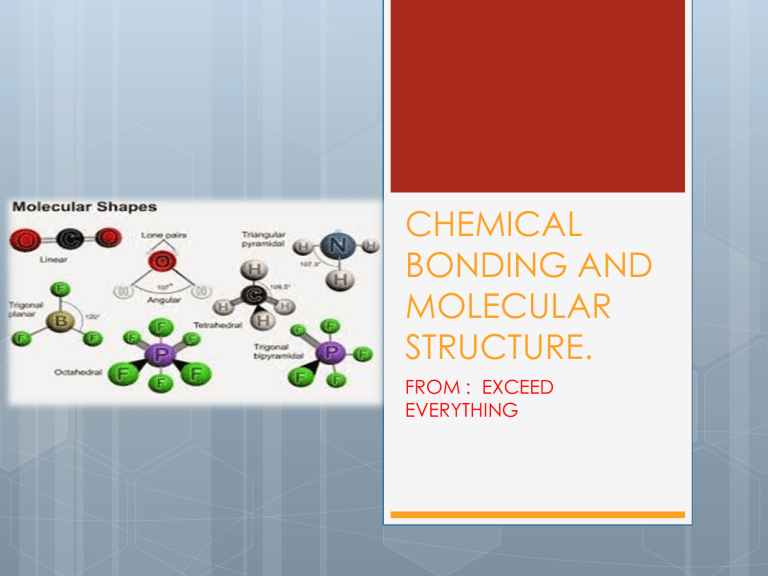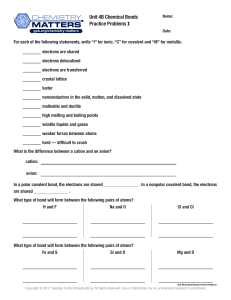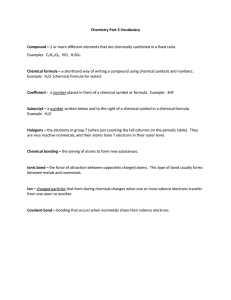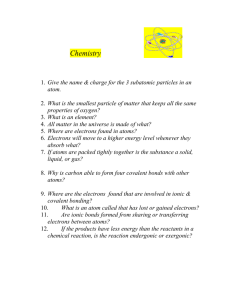
CHEMICAL BONDING AND MOLECULAR STRUCTURE. FROM : EXCEED EVERYTHING IMPORTANT TOPICS :-Ionic vs. covalent bonding • Valence electron & Lewis dot structures octet vs. non-octet resonance structures formal charges • VSEPR - predicting shapes of molecules • Bond properties polarity, bond order, bond strength • CHEMICAL BONDS Atoms or ions are held together in molecules or compounds by chemical bonds. The type and number of electrons in the outer electronic shells of atoms or ions are instrumental in how atoms react with each other to form stable chemical bonds. Over the last 150 years scientists developed several theories to explain why and how elements combine with each other. Bonding in Chemistry Central theme in chemistry: Why and How atoms attach together This will help us understand how to: 1. 2. 3. Predict the shapes of molecules. Predict properties of substances. Design and build molecules with particular sets of chemical and physical properties. CHEMICAL BONDS Two of the most common substance on our dining table are salt and granulated sugar NaCl C12H22O11 The properties of substances are determined in large part by the chemical bonds that hold their atoms together Chemical Bonds All chemical reactions involve breaking of some bonds and formation of new ones which yield new products with different properties. Bonding Theories Lewis bond Theory Valence Bond Theory Molecular Orbital Theory Gilbert Newton Lewis Lewis Bonding Theory Atoms ONLY come together to produce a more stable electron configuration. Atoms bond together by either transferring or sharing electrons. Many of atoms like to have 8 electrons in their outer shell. Octet rule. There are some exceptions to this rule—the key to remember is to try to get an electron configuration like a noble gas. Li and Be try to achieve the He electron arrangement. Lewis Symbols of Atoms Uses symbol of element to represent nucleus and inner electrons. Uses dots around the symbol to represent valence electrons. Puts one electron on each side first, then pair. Remember that elements in the same group have the same number of valence electrons; therefore, their Lewis dot symbols will look alike. Li• Be• • •B• • • •C• • •• •N• • •• •O: • •• :F: • •• :Ne: •• Valence electrons Practice to write the Lewis symbol for Arsenic As is in group 15 (5), therefore it has 5 valence electrons. As Examples for Lewis representation of some chemical bonds •• •• •• •• •• •• H •• •O •• • F O •H •• •O •• • F H •• •• F •• H• • O •• •• • •• •F •• •• •• •• F• •• •• F •• O •• •• O O O Example: Write the Lewis structure of CO2. Information: Given: CO2 Find: Lewis structure Solution Map: formula → skeletal → electron distribution → Lewis Total number of valence electrons = 6 + 4 + 6 = 16 Actually 24 electrons needed for completing the octet of each atom Thus 24 - 16 = 8 electrons are shared. Since two electrons make a bond, the molecule should have 4 bonds. The remaining 8 electrons are lone pair electrons. .. O .. C .. O .. Example NO3─ - Write skeletal structure. N is central because it is the most metallic. Count valence electrons. N=5 O3 = 3 x 6 = 18 (-) = 1 Total = 24 e- TYPES OF CHEMICAL BONDS Ionic bonds Covalent Metallic bonds bonds Ionic compounds consist of a cation and an anion • the formula is always the same as the empirical formula • the sum of the charges on the cation and anion in each formula unit must equal zero. Lewis bonding theory is able to explain ionic bonds very well. The ionic compound NaCl Ionic bonding Ionic substances are formed when an atom that loses electrons relatively easily react with an atom that has a high affinity for electrons. ex. metal-nonmetal compound Chemical Bonds Ionic bonds are formed by the attraction of oppositely charged ions. Ionic Bonds Metal to nonmetal. Metal loses electrons to form cation. Nonmetal gains electrons to form anion. The electronegativity between the metal and the nonmetal must be > than 2. Ionic bond results from + to − attraction. Larger charge = stronger attraction. Smaller ion = stronger attraction. Lewis theory allows us to predict the correct formulas of ionic compounds. Ions that pack as spheres in a very regular pattern are called crystalline substances . Formation of an Ionic Solid 1. Sublimation of the solid metal M(s) → M(g) [endothermic] 2. Ionization of the metal atoms M(g) →M+(g) + e- [endothermic] 3. Dissociation of the nonmetal 1/2X2(g) → X(g) [endothermic] Electron affinity of F Dissociation of F2 Ionization of Li Sublimation of Li Formation of solid What is Lattice Energy? A measure of the energy contained in the crystal lattice of a compound, equal to the energy that would be released if the component ions were brought together from infinity. More Gains and Losses • Can elements lose or gain more than one electron? • The element magnesium, Mg, in Group 2 can lose two electron and element oxygen in Group 6 can gain two electrons to form stable Nobel gas configurations. The ions can come together to form a crystal structure. Relative sizes of some ions and their parent atoms. Structure of ionic crystals Different types of crystals are formed depending on the ionic radii and the charge of the ions involved. Convalent Bonds—Sharing • Some atoms are unlikely to lose or gain electrons because the number of electrons in their outer levels makes this difficult. • Consider the Lewis dot structure of carbon . . C. . C+4 + 4e- • The alternative is sharing electrons. Covalent Bonds Often found between two nonmetals. Typical of molecular species. Atoms bonded together to form molecules. Strong attraction. Atoms share pairs of electrons to attain octets. Molecules generally weakly attracted to each other. Observed physical properties of molecular substance due to these attractions. Covalent Bonding Electron are shared by nuclei The Convalent Bond • Shared electrons are attracted to the nuclei of both atoms. • They move back and forth between the outer energy levels of each atom in the covalent bond. • So, each atom has a stable outer energy level some of the time. The formation of a bond between two atoms. An electron density plot for the H2 molecule shows that the shared electrons occupy a volume equally distributed over BOTH Hydrogen atoms. Electron Density for the H2 molecule Chemical Bonds Covalent bonds form when atoms share 2 or more valence electrons. Covalent bond strength depends on the number of electron pairs shared by the atoms. single bond < double bond < triple bond Examples of Convalent Bond • The neutral particle is formed when atoms share electrons is called a molecule Single Covalent Bonds Two atoms share one pair of electrons. 2 electrons. One atom may have more than one single bond. •• F •• •• F H• H •H O H •• F •• •• F •• •• •• •• • F •• •• •• •O •• •• • F • •• •• •• •• Double Covalent Bond Two 4 atoms sharing two pairs of electrons. electrons. Shorter and stronger than single bond. •• •O •• • • •• •O •• O •• •• O O O Chemical Bonds Bond Polarity Bonding between unlike atoms results in unequal sharing of the electrons. One atom pulls the electrons in the bond closer to its side. One end of the bond has larger electron density than the other. The result is bond polarity. The end with the larger electron density gets a partial negative charge and the end that is electron deficient gets a partial positive charge. d+ H •• Cl d- Nonpolar and polar covalent bonds Probability representations of the electron sharing in HF. Trends in electronegativity across a period and down a group In practice no bond is totally ionic. There will always be a small amount of electron sharing. Percent ionic character of chemical bonds as a function of electronegativity difference Bond Polarity and Dipole Moments Dipole Moment μ=QR Q: center of charge of magnitude R: distance Dipole Moment of HF 1D=3.336×10-30 coulomb meter μ=(1.6×10-19 C)(9.17×10-11 m)=1.47×10-29 =4.4 D for fully ionic Measured dipole moment=1.83 D 1.83×3.336×10-30=δ(9.17×10-11) δ=6.66×10-20 Ionic character=1.83/4.4=41.6% Polar Molecules and Electric Field Molecular Geometry Molecules are three-dimensional objects. We often describe the shape of a molecule with terms that relate to geometric figures. These geometric figures have characteristic “corners” that indicate the positions of the surrounding atoms with the central atom in the center of the figure. The geometric figures also have characteristic angles that we call bond angles. Valence Shell Electron Pair Repulsion (VSEPR Model) It is used to predict the geometries of molecules formed from nonmetals. Postulate: the structure around a given atom is determined principally by minimizing electron pair repulsion. The bonding and nonbonding pairs should be positioned as far apart as possible. Predicting a VSEPR Structure Draw Lewis structure. Put pairs as far apart as possible. Determine positions of atoms from the way electron pairs are shared. Determine the name of molecular structure from positions of the atoms. For non-metals compounds, four pairs of electrons around a given atom prefer to form a tetrahedral geometry Draw the Lewis structure Count the pairs of electrons and arrange them to minimize repulsions Determine the positions of the atoms Name the molecular structure Lone pairs require more space than bonding pair. The bonding pairs are increasingly squeezed together as the number of lone pairs increases. The bonding pair is shared between two nuclei; and the electrons can be close to either nucleus. A lone pair is localized on only one nucleus, so both electrons are close to that nucleus only. Molecular Geometries Electron Pairs Practice drawing these shapes below Linear TP Tetra TBP Octa Polarity of Molecules In order for a molecule to be polar it must: 1. Have polar bonds. Electronegativity difference—theory. Bond dipole moments—measured. 2. Have an unsymmetrical shape. Vector addition. Polarity effects the intermolecular forces of attraction. Molecule Polarity The O—C bond is polar. The bonding electrons are pulled equally toward both O ends of the molecule. The net result is a nonpolar molecule. Molecule Polarity The H—O bond is polar. Both sets of bonding electrons are pulled toward the O end of the molecule. The net result is a polar molecule. Water molecule behaves as if it had a positive and negative end. The Covalent Chemical Bond Bond Energies Bond breaking requires energy (endothermic). Bond formation releases energy (exothermic). DH = SD(bonds broken) - SD(bonds formed) energy required energy released Bond Energies Covalent Bond Energies and Chemical Reactions H2+F2→2HF ΔH=ΣD (bonds broken)-ΣD (bonds formed) ΔH=DH-H+DF-F-2DH-F=1×432+1×154-2×565 =-544 kJ Bond Energy of CH4 Experimental result : 1652 kJ/mol C(g)+4H(g) →CH4(g) + 1652 kJ/mol An average C-H bond energy per mole of C-H bond: 1652/4=413 (kJ/mol) Metallic Bonding The model of metallic bonding can be used to explain the properties of metals. The luster, malleability, ductility, and electrical and thermal conductivity are all related to the mobility of the electrons in the solid. The strength of the metallic bond varies, depending on the charge and size of the cations, so the melting points and DHfusion of metals vary as well. IONIC COMPOUNDS vs METALS BREAKING INORGANIC MATERIAL SLIP PLANES ALLOY vs PURE METAL



